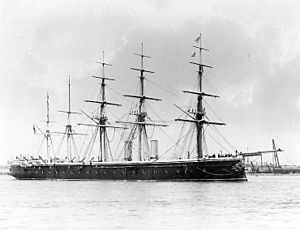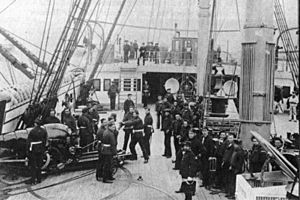HMS Minotaur (1863) facts for kids

Minotaur at anchor
|
|
Quick facts for kids History |
|
|---|---|
| Name | HMS Minotaur |
| Namesake | Minotaur |
| Ordered | 2 September 1861 |
| Builder | Thames Ironworks and Shipbuilding Company |
| Laid down | 12 September 1861 |
| Launched | 12 December 1863 |
| Completed | 1 June 1867 |
| Commissioned | April 1867 |
| Fate | Sold for scrap, 1922 |
| General characteristics (as completed) | |
| Class and type | Minotaur-class armoured frigate |
| Displacement | 10,627 long tons (10,798 t) |
| Length |
|
| Beam | 59 ft 6 in (18.1 m) |
| Draught | 27 ft 9 in (8.5 m) |
| Installed power | 6,949 ihp (5,182 kW) |
| Propulsion |
|
| Sail plan | 5-masted |
| Speed | 14 knots (26 km/h; 16 mph) |
| Range | 1,500 nmi (2,800 km; 1,700 mi) at 7.5 kn (13.9 km/h; 8.6 mph) |
| Complement | 800 actual |
| Armament | |
| Armour |
|
HMS Minotaur was a very powerful warship, the first of her kind, built for the British Royal Navy in the 1860s. She was an armoured frigate, meaning she was a large sailing warship protected by iron armour. It took almost four years from when she was launched until she was ready for duty. This was because the Navy tested her weapons and sails very carefully.
For most of her active life, Minotaur was the main ship (called the flagship) of the Channel Squadron. This important role included taking part in Queen Victoria's big naval parade in 1887. Later, in 1893, she became a training ship. In 1905, she was turned into a hulk (a ship that can no longer sail) and became part of a training school. Minotaur was given several new names before she was finally sold for scrap in 1922.
Contents
Building a Mighty Warship
The Minotaur-class armoured frigates were like bigger, stronger versions of an earlier ship called HMS Achilles. They had heavier armour, more powerful engines, and bigger guns. These ships were designed to carry 50 guns along their sides, and their entire sides were covered in armour to protect them. Each ship also had a special plough-shaped ram at the front, which was used to smash into enemy ships.
The Minotaur-class ships were about 400 feet (121.9 m) long. This is longer than a football field! They were also 58 feet 6 inches (17.8 m) wide and sat 26 feet 10 inches (8.2 m) deep in the water. These ships were very heavy, weighing about 10,627 long tons (10,798 t). To make them strong and safe, their hulls were divided into 15 watertight sections. They also had a double bottom under the engine and boiler rooms, which helped prevent sinking if the outer hull was damaged.
When she was first built, Minotaur was known for being good in rough seas and a stable platform for her guns. However, she was hard to steer using her steam engine and very difficult to manage under sail. In 1875, new steam-powered steering was added, which made her much easier to control. By 1890, a high-ranking admiral even called her "one of our very best manoeuvrers."
How She Moved: Engines and Sails
Minotaur had a large two-cylinder steam engine built by John Penn and Sons. This engine turned a single 24-foot (7.3 m) propeller, pushing the ship through the water. Ten large boilers created the steam needed to power the engine. During her sea trials in 1867, her engine produced 6,949 indicated horsepower (5,182 kW) of power, allowing Minotaur to reach a top speed of 14.33 knots (26.54 km/h; 16.49 mph) (about 16.5 miles per hour). She could carry enough coal to travel 1,500 nmi (2,800 km; 1,700 mi) (about 1,726 miles) at a slower speed of 7.5 knots (13.9 km/h; 8.6 mph).
The ship also had five masts and a huge sail area of 32,377 square feet (3,008 m2). However, her propeller could not be lifted out of the water, which created drag and slowed her down when sailing. Because of this, Minotaur could only reach 9.5 knots (17.6 km/h; 10.9 mph) under sail. Both of her funnels could be partly lowered to reduce wind resistance when she was sailing. One admiral described Minotaur and her sister ships as "the dullest performers under canvas" because they carried so much sail but didn't move well with it. After she stopped active service in 1893–94, two of her masts were removed, and her sails were changed to a barque rig.
Powerful Weapons

The Minotaur-class ships were originally meant to have 40 large breech-loading guns on the main deck and 10 more on the upper deck. However, these new guns didn't work out well. Instead, Minotaur was armed with a mix of seven-inch (178 mm) and nine-inch (229 mm) rifled muzzle-loading guns.
She carried four of the large nine-inch (229 mm) guns and 20 of the seven-inch (178 mm) guns on her main deck. Four more seven-inch (178 mm) guns were placed on the upper deck to fire forwards or backwards (called chase guns). She also had eight smaller brass howitzers for firing salutes. The openings for the guns were wide enough to allow each gun to aim 30 degrees forwards or backwards from the side of the ship.
The nine-inch (229 mm) gun fired a shell weighing 254 pounds (115.2 kg). It could shoot the shell at 1,420 ft/s (430 m/s) and was strong enough to punch through 11.3 inches (287 mm) of iron armour. The seven-inch (178 mm) gun fired a 112-pound (50.8 kg) shell and could go through 7.7-inch (196 mm) of armour.
In 1875, Minotaur was rearmed with 17 uniform nine-inch (229 mm) guns. To fit these larger guns, the gun openings had to be made bigger by hand. Later, around 1883, two of the nine-inch (229 mm) guns were replaced with six-inch (152 mm) breech-loading guns. In 1891–92, she received even more modern weapons: four quick-firing (QF) four-point-seven-inch (119 mm) guns, eight QF three-pounder[convert: unknown unit] Hotchkiss guns, eight machine guns, and two torpedo tubes.
Strong Armour Protection
The entire side of the Minotaur-class ships was protected by wrought iron armour. This armour was 4.5 inches (114 mm) thick at the ends of the ship and 5.5 inches (140 mm) thick in the middle. It extended 5 feet 9 inches (1.8 m) below the waterline to protect the ship's vital areas. A 5.5 inches (140 mm) thick armoured wall (called a bulkhead) protected the forward chase guns on the upper deck. Behind the iron armour, there was a 10 inches (254 mm) layer of strong teak wood, which helped absorb the impact of enemy shells.
Building and Service History
HMS Minotaur was first ordered on September 2, 1861, and was going to be named HMS Elephant. However, her name was changed to Minotaur while she was being built. She was laid down (meaning her construction began) on September 12, 1861, by the Thames Ironworks and Shipbuilding Company in Blackwall, London. She was launched into the water on December 12, 1863. She was officially ready for duty in April 1867 and fully completed by June 1, 1867. The long delay was because her design was changed many times, and the Navy spent a lot of time testing her weapons and sailing equipment. The ship cost a total of £478,855 to build.
Minotaur began her service in Portsmouth as the flagship of the Channel Squadron, a role she kept until 1873. In 1872, she almost crashed into another ironclad ship, HMS Bellerophon, while leaving Belfast Lough. Minotaur lost her bowsprit (the pole sticking out from the front) and a top mast, but Bellerophon only had minor damage. After a long refit (repair and upgrade), Minotaur rejoined the Channel Squadron in 1875. In 1876, she became the first ship in the Royal Navy to have a permanent electric searchlight. On December 24, 1886, she collided with HMS Monarch in the Tagus river, causing serious damage to Monarch.
On February 28, 1887, Minotaur helped rescue the passengers and crew of the British steamship Valparaiso, which had crashed on a reef off Vigo, Spain. Minotaur was the flagship of Vice Admiral Sir William Nathan Wrighte Hewett during Queen Victoria's Golden Jubilee Fleet Review on July 23, 1887. She was taken out of active service at the end of 1887 in Portsmouth and placed in the Reserve fleet.
In 1893, she became a training ship at Portland. Her name was changed to HMS Boscawen II in March 1904. In 1905, she was moved to Harwich to become part of the training school called HMS Ganges. Her name was changed again to HMS Ganges on June 11, 1906, and then to Ganges II on April 25, 1908. Finally, she was sold for scrap on January 30, 1922.
Images for kids
-
Minotaur's deck in the late 1860s. A 7-inch muzzle-loading rifle on a wrought iron pivot gun carriage is at lower left.





